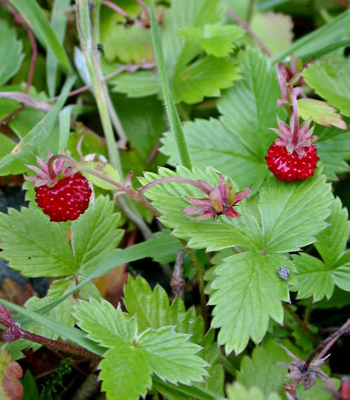Contents:
Common Names | Parts Usually Used | Plant(s) & Culture | Where Found | Medicinal Properties | Biochemical Information
Uses | Formulas or Dosages | Nutrient Content | Warning | Bibliography
Scientific Names

- Fragaria vesca L.
- Rosaceae
- Rose family
Common Names
- Alpine strawberry
- Common strawberry
- Mountain strawberry
- Pineapple strawberry
- Wild strawberry
Parts Usually Used
Leaves, berries and root
Back to Top
Description of Plant(s) and
Culture
A small, perennial plant, with long runners; 3-6 inches high. These runners root at the nodes to form tufts of long-stalked, hairy leaves, each with 3 toothed leaflets. Leaves pointed, not rounded, at the tip. Small, flat clusters of white 5 petaled flowers grow on long stalks, the sepals are joined together behind each flower; calyx lobes spreading or recurved. Flowers in May to August. Fruits with seeds on surface (small strawberries).
This wild strawberry differs from the cultivated species (F. virginiana) in that its leaves are more pointed and the fruits have seeds on the surface, rather than embedded in the fruits.
Back to Top
Where Found
Woods, embankments, along the edges of forest paths, in clearings, in sunny glades, and meadows. Canada to Virginia; Missouri to North Dakota, Iowa, and in the Rockies from Alaska to New Mexico. Native to Europe.
Back to Top
Medicinal Properties
Diuretic, tonic, stomachic, mild astringent
Back to Top
Biochemical Information
Vitamin C, tannin
Back to Top
Uses
Native Americans used root tea for stomach ailments, jaundice, profuse menses. In European folk medicine, leaf tea used as a blood purifier, for indigestion, and as a diuretic for gravel in the kidney. Tea also used as an external wash on sunburn. Root tea is a diuretic. Root can be used as a chewed stick for a substitute for a toothbrush. Teeth that have become discolored or encrusted with tartar can be cleaned with strawberry juice.
Strawberry leaves are used for eczema, the outward appearance of acute or chronic blood contamination, as a blood purifier, and blood building agents. Poultices of leaves can be used to treat ulcers and infected wounds. Use a strong tea or decoction of leaves or roots sweetened with honey and use freely for children and adults for intestinal malfunctions of diarrhea, dysentery, weakness of the intestines, affections of the urinary tract. Will prevent night sweats or, a strong tea used as a gargle will strengthen the gums. Berries said to be effective in reducing fever. Fresh juice can be used to clean the skin.
Back to Top
Formulas or Dosages
Use dried young leaves and roots; garden strawberries less effective.
Decoction: 1 tsp. fresh or dried herb to 1 cup of boiling water, steep 15 minutes. Take 4-5 cups a day; children wineglassful amounts.
Tincture: 5-15 drops in water 3 times a day.
Back to Top
Nutrient Content
Berries have high vitamin C content
Back to Top
Warning
Juice of berries can cause dermatitis in sensitive or allergic conditions.
Back to Top
Bibliography
![]() Back to Eden
Back to Eden, by Jethro Kloss; Back to Eden Publishing Co., Loma Linda, CA 92354, Original copyright 1939, revised edition 1994
![]() Eastern/Central Medicinal Plants
Eastern/Central Medicinal Plants, by Steven Foster and James A. Duke., Houghton Mifflin Company, 215 Park Avenue South, New York, NY 10000
 The Magic of Herbs
The Magic of Herbs, by David Conway, published by Jonathan Cape, Thirty Bedford Square, London, England. (Out of print)
![]() The Complete Medicinal Herbal
The Complete Medicinal Herbal, by Penelope Ody, Dorling Kindersley, Inc, 232 Madison Avenue, New York, NY 10016, First American Edition, copyright 1993
![]() Indian Herbalogy of North America
Indian Herbalogy of North America, by Alma R. Hutchens, Shambala Publications, Inc., Horticultural Hall, 300 Massachusetts Avenue, Boston, Massachusetts 02115, 1973
![]() American Folk Medicine
American Folk Medicine, by Clarence Meyer, Meyerbooks, publisher, PO Box 427, Glenwood, Illinois 60425, 1973
![]() Webster’s New World Dictionary
Webster’s New World Dictionary, Third College Edition, Victoria Neufeldt, Editor in Chief, New World Dictionaries: A Division of Simon & Schuster, Inc., 15 Columbus Circle, New York, NY 10023
 How Indians Use Wild Plants for Food, Medicine & Crafts
How Indians Use Wild Plants for Food, Medicine & Crafts, by Frances Densmore, Dover Publications, Inc., 180 Varick Street, New York, NY 10014, first printed by the United States Government Printing Office, Washington, in 1928, this Dover edition 1974
 An Instant Guide to Medicinal Plants
An Instant Guide to Medicinal Plants, by Pamela Forey and Ruth Lindsay, Crescent Books (January 27, 1992).
 The Healing Plants
The Healing Plants, by Mannfried Pahlow, Barron’s Educational Series, Inc. 250 Wireless Blvd., Hauppauge, NY 11788, 1992
